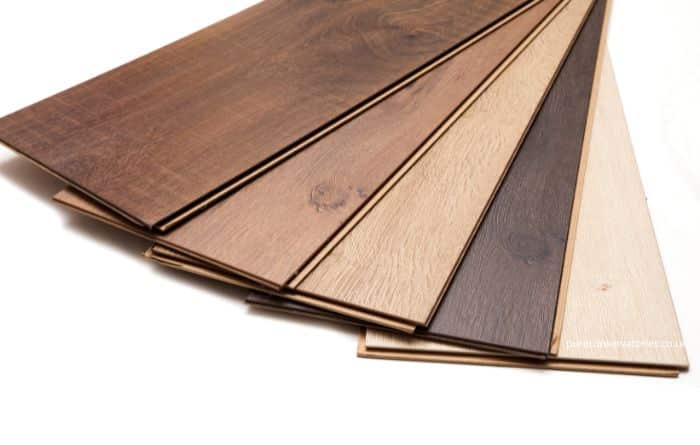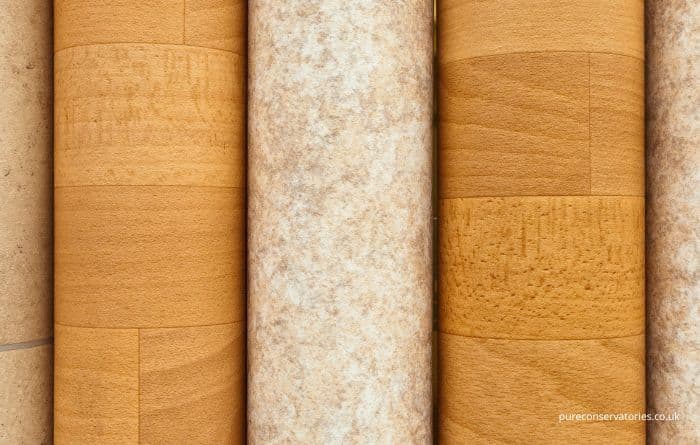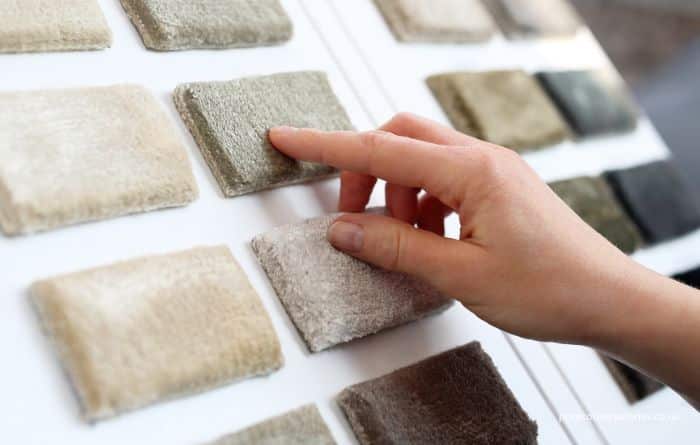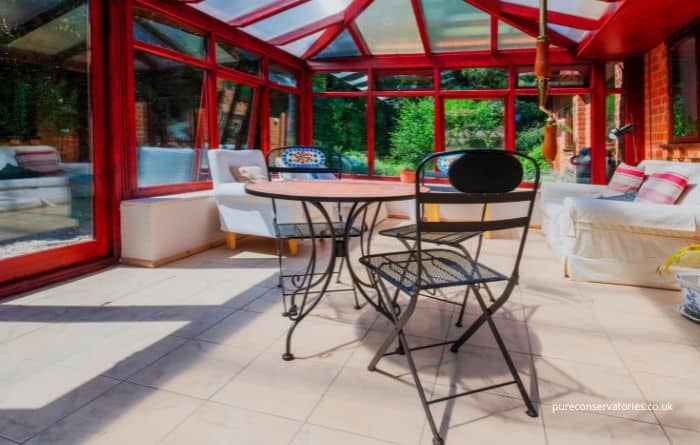What Is The Best Flooring For Conservatories?
If you’re looking for the best flooring for your conservatory, we’ll be happy to offer our advice! From laminate and vinyl to tiles and wooden boards, there are plenty of choices – each designed to provide a durable, low-maintenance solution that can cope with temperature fluctuations and sunlight exposure. Plus, they’ll look stunning too, complementing your home’s decor perfectly.
In this article, we will explore some of the top conservatory flooring options and their advantages and disadvantages to help you decide which will be best for you.
Benefits Of Laminate Flooring For Conservatories
Laminate flooring is a type of synthetic flooring made from several layers of materials that are fused. Typically, a laminate floor consists of a high-density fiberboard (HDF) core that provides stability, a photographic layer that mimics the look of wood or other materials, and a clear protective layer on top.
The layers are bonded under high pressure and temperature, resulting in a durable and affordable flooring option. Laminate flooring is available in a wide range of colours, patterns, and textures and is easy to install using a click-and-lock system or glue-down method.
Laminate flooring is a popular choice for conservatories for several reasons.
- It is highly durable and scratch-resistant, making it ideal for high-traffic areas. This is especially important in a conservatory, which may see heavy foot traffic and exposure to the elements.
- It is easy to install and maintain, with many options available that can be clicked together without needing adhesives or nails. This means that it can be installed quickly and easily, saving you time and money.
- Laminate flooring is available in a wide range of styles and colours, allowing you to choose a look that complements the rest of your home’s decor.
- Laminate flooring is typically more affordable than other flooring options, such as hardwood or stone, making it a great choice for those on a budget.
Downsides To Laminate Flooring For Conservatories
- Susceptibility to temperature changes: Conservatories are exposed to extreme temperature changes, and laminate flooring can expand or contract due to these changes. This can cause the flooring to warp or buckle, leading to costly repairs or replacements.
- Sun damage: The sun’s UV rays can cause laminate flooring to fade or discolour over time, especially in areas that receive direct sunlight. This can also lead to the need for replacement.
- Moisture damage: Conservatories are prone to moisture due to their location and often have higher humidity levels. If moisture seeps under the laminate flooring, it can cause damage to the subfloor, leading to mould and mildew growth.
- Noise: Laminate flooring can be noisy underfoot, which may be an issue in conservatories that are used as living spaces or home offices.
- Limited lifespan: While laminate flooring is durable, it has a limited lifespan compared to other flooring options such as hardwood or tile. This means that it may need to be replaced sooner than other flooring options, resulting in additional costs.
Advantages Of Vinyl Flooring For Conservatories
Vinyl flooring is a popular choice for conservatories due to its durability, affordability, and versatility. Vinyl flooring is a type of synthetic flooring made from a combination of PVC (polyvinyl chloride) and other compounds. It is available in sheets, tiles, or planks and can be installed using a variety of methods, including glue-down, click-lock, or loose-lay. This type of flooring can mimic the look of other flooring types, such as hardwood or tile, but is more affordable and easier to maintain.
Here are some advantages of using vinyl flooring for conservatories:
- Resistant to moisture: Vinyl flooring is highly resistant to moisture, making it an ideal choice for conservatories where humidity levels can be high. It is also water-resistant, making cleaning up spills and stains easy.
- Durable: Vinyl flooring is highly durable and can withstand heavy foot traffic and daily wear and tear. It is also scratch-resistant, making it ideal for use in conservatories that may see a lot of activity.
- Versatile: Vinyl flooring is available in a wide range of colours, patterns, and textures, making it easy to find a style that complements the decor of your conservatory. It can also mimic the look of other flooring types, such as hardwood or tile.
- Easy to install: Vinyl flooring is relatively easy to install, which can save time and money compared to other flooring options.
- Comfortable: Vinyl flooring is softer underfoot than other flooring types, making walking more comfortable for extended periods.
- Affordable: Vinyl flooring is one of the most affordable flooring options, making it an excellent choice for conservatories where you may be working within a budget.
Downsides of Of Vinyl Flooring For Conservatories
- Limited design options: While vinyl flooring is available in various colours and patterns, it may not offer as many design options as other flooring types, such as hardwood or tile.
- Prone to fading: Some types of vinyl flooring can be prone to fading or discolouration over time, especially in areas that receive direct sunlight.
- Not as eco-friendly: Vinyl flooring is made from synthetic materials, which may not be as eco-friendly as other options, such as bamboo or cork.
- Susceptible to scratches: While vinyl flooring is generally scratch-resistant, it can still be susceptible to scratches from sharp or heavy objects, detracting from its appearance over time.
- Can emit VOCs: Some types of vinyl flooring may emit volatile organic compounds (VOCs), which can harm indoor air quality and health, especially for those with allergies or respiratory issues.
Advantages Of Carpet In Conservatories
Carpet is a popular flooring option made of fibres woven or tufted together to create a soft, cushioned surface. Carpets come in various materials, such as wool, nylon, polyester, and acrylic.
They also come in different styles, including plush, Berber, frieze, and shag. Carpets can be installed using different methods, including stretching over a pad, glueing to the subfloor, or simply laying it down as a rug.
Carpet can be a cosy and comfortable flooring option for conservatories, offering a range of advantages:
- Insulation: Carpet provides insulation against cold or damp floors, making it a great choice for conservatories that can get chilly during the winter months.
- Softness: The carpet is soft and comfortable underfoot, which can be especially important if you spend a lot of time in your conservatory.
- Sound absorption: The carpet helps to absorb sound, which can be particularly beneficial in conservatories where noise can reverberate.
- Design options: Carpet is available in a wide range of colours, patterns, and textures, allowing you to choose a design that complements your decor and personal style.
- Safety: Carpet can provide a non-slip surface, which can be particularly important in conservatories where water or spills may be present, reducing the risk of falls and accidents.
Downsides of Using Carpet For Conservatory Flooring
While carpet can be a comfortable and cosy flooring option for conservatories, there are a few downsides to consider:
- Maintenance: Carpet can be more difficult to clean and maintain than other flooring options, especially in a room that receives a lot of sunlight and foot traffic.
- Staining: Carpet is prone to staining, particularly if spills are not cleaned up immediately. This can be a concern in a conservatory where frequent exposure to drinks, food, and other substances may occur.
- Fading: Sunlight can cause carpets to fade over time, which can be particularly noticeable in a conservatory that receives a lot of natural light.
- Allergies: Carpets can trap dust, dirt, and allergens, which can be a concern for those with allergies or respiratory issues.
- Cost: Carpet can be a more expensive option than other flooring types, especially if you choose high-quality materials.
Benefits Of Conservatory Floor Tiles
Floor tiles are a flooring material made from various materials such as ceramic, porcelain, natural stone, or glass. They are available in a wide range of shapes, sizes, colours, and patterns, making them a versatile choice for any interior design.
Tiles are known for their durability, resistance to wear and tear, and ease of maintenance. They can be used in various areas of a house, including bathrooms, kitchens, living rooms, and conservatories, due to their ability to withstand moisture, stains, and scratches.
Conservatory floor tiles are an excellent choice for flooring in a conservatory because:
- Tiles are incredibly durable and can withstand high foot traffic, making them ideal for a frequently used room.
- They are also resistant to scratches, stains, and moisture, which is particularly important for a room with high exposure to the elements.
- Tiles come in various styles, colours, and patterns, which means they can complement any interior design and add a touch of elegance to your conservatory.
- Tiles are easy to clean and require minimal maintenance, which is perfect for busy households. Lastly, tiles have excellent thermal conductivity, which means that they can absorb and retain heat, making them an ideal choice for a room that can experience significant temperature fluctuations.
Downsides To Tiled Conservatory Flooring
- One of the main disadvantages of tiles is that they can be cold underfoot, which may not be ideal for some homeowners.
- The hard surface of tiles can make them less comfortable to stand or sit on for long periods.
- Floor tiles can also be slippery when wet, which can be a safety concern for children and the elderly.
- The installation and materials cost can be higher than other flooring options such as laminate or vinyl.
Can You Use Real Wood Flooring For Conservatories?
When it comes to conservatories, solid wood or engineered wood flooring is not a practical option due to their tendency to expand and contract in response to fluctuations in temperature and moisture levels.
This can lead to warping, lifting, and cracking of the flooring throughout the year. Additionally, exposure to high levels of UV radiation can cause real wood to bleach, which can be prevented with treatments, but it may not be ideal if you want to keep your conservatory floor looking its best. As a result, solid and engineered wood flooring is better suited for areas such as living rooms or dining rooms where a more rustic aesthetic is desired.
Using Rugs In Conservatories
Rugs in conservatories can be a great way to add warmth, texture, and colour to the space. Rugs can help define different conservatory areas and create a cosy and inviting atmosphere. They also provide an extra insulation layer, making the conservatory feel more comfortable and warm underfoot. Rugs come in various materials, sizes, and designs, allowing you to choose one that complements your decor style and personal preferences.
You can find affordable rugs specifically designed for conservatories that are UV-resistant and easy to clean. When the rug starts to show wear and tear with use, it can be replaced easily. This makes rugs an ideal choice for conservatories, as they can be changed out more frequently than floor tiles.
How To Install Conservatory Flooring
Installing conservatory flooring can be a straightforward and rewarding DIY project, especially with the help of easy-to-fit flooring options. Plenty of laminate and vinyl flooring products feature a quick-click installation system, which makes the process simple and intuitive. This means that whether you’re an experienced DIY enthusiast or a novice, you can easily install flooring in your conservatory.
Things To Consider When Selecting Flooring For A Conservatory
When it comes to selecting flooring for a conservatory, whether it is a brand-new build or a revamp of your existing structure, there are several important factors to consider.
- First, think about the purpose of your conservatory. If you’re planning to use the space as an extension of your living room, you may want a flooring option that is comfortable and cosy, such as carpet or cork. On the other hand, if you’re planning to use the conservatory as a dining area, you may prefer a hard-wearing flooring option that is easy to clean, such as tiles or vinyl. If the conservatory has a door leading to a garden, it’s necessary to think about how to keep dirt and debris out too!
- Second, consider the amount of natural light that enters your conservatory. Lighter flooring options, such as light-coloured tiles or wood, can help to brighten up a dark conservatory, while darker options can add warmth and depth to a brightly-lit space.
- If you have a conservatory, be aware that it may experience a lot of sun exposure which can cause problems for your flooring. Extended exposure to UV rays can cause bleaching. Additionally, the temperature in the conservatory can vary greatly, making it a pleasant sunroom in summer but chilly in winter, meaning you might want to consider underfloor heating options.
- Temperature Regulation, especially during extreme weather conditions is important.
- Third, think about the style of your home and the overall look you want to achieve. Whether you prefer a traditional, rustic, or modern aesthetic, there is a conservatory flooring option that will complement your design choices.
- Finally, consider your budget and how much maintenance you’re willing to do. Some flooring options may be more expensive upfront but require less maintenance over time, while others may be cheaper but need regular upkeep to stay looking their best.
Consider These Things To Narrow Down Your Conservatory Flooring Options
Which room will your conservatory be connected to?
The adjoining room should influence the type of flooring you select for your conservatory. For instance, if the conservatory is connected to the kitchen, it’s best to choose spill-resistant and water-resistant flooring like vinyl or laminate. Alternatively, a carpet may be suitable if the conservatory is connected to the living room and doesn’t have a direct exit to the garden.
Will the conservatory receive an abundance of sunlight?
If you want to enjoy the sunshine in your conservatory, it’s best to be mindful of its impact on your flooring. To prevent uneven discolouration, try moving your furniture around regularly so that no one area is constantly exposed to the sun. You may also want to choose flooring with UV protection to help minimise any fading.
Underfloor heating
Installing underfloor heating is one way to keep your conservatory floor warm and cosy. Before selecting the best flooring type for your conservatory, it’s worth considering the underfloor heating option, as it won’t work with all flooring types.
Underfloor heating is a great choice if you’re looking for a consistent and comfortable temperature throughout your conservatory and can provide an extra boost of warmth during colder months to make the space usable all year around. By choosing underfloor heating, you can ensure that your conservatory flooring is not only functional but also comfortable and inviting.
Summary
We hope this article has given you a clear breakdown of some of the most popular options available when it comes to choosing the floor for a conservatory. To recap, when deciding on the right flooring, it’s essential to consider the temperature changes that the room will experience, your budget, the use of the room and the style you want to achieve.
To sum up, solid wood flooring is not recommended in the conservatory due to its tendency to contract and expand, while engineered wood may be a better option but is still susceptible to temperature changes. Laminate, vinyl, and tiles are popular flooring choices for conservatories, with laminate being one of the most cost-effective and practical options. Not only is laminate easy to clean and maintain, but it is also stain, scratch, and impact resistant. Additionally, it provides a modern and contemporary look to any conservatory.
If you want to create a cosier ambience, you can add a small rug, but ensure to clean it regularly to avoid collecting dirt from the outdoors.
Where Are You Based?
We are based in the Wirral but serve the surrounding areas, see the following pages for more details about our services and where we offer them:
conservatories Liverpool, orangeries Liverpool, conservatories & orangeries Chester, conservatories & orangeries Wirral, conservatories & orangeries Warrington, conservatories & orangeries Southport
If you are not in one of these areas please get in touch. These are our main focus areas but we’re happy to have a chat about working in your area.




